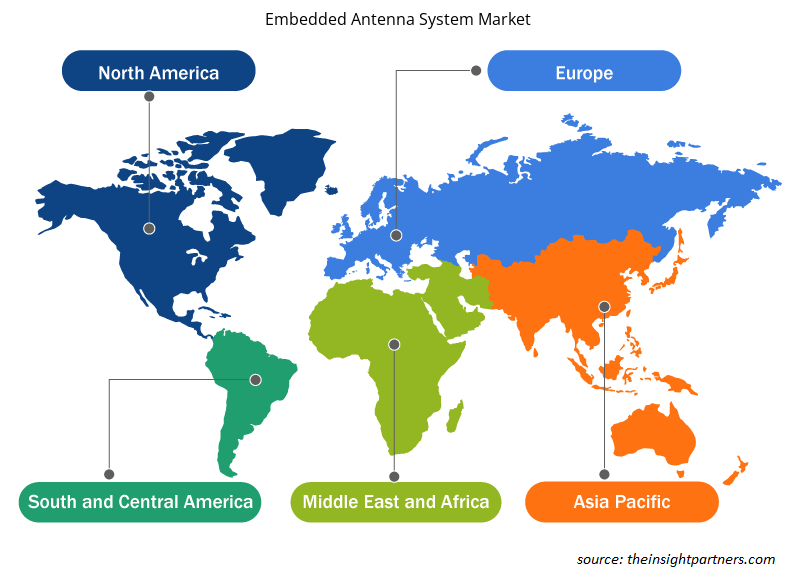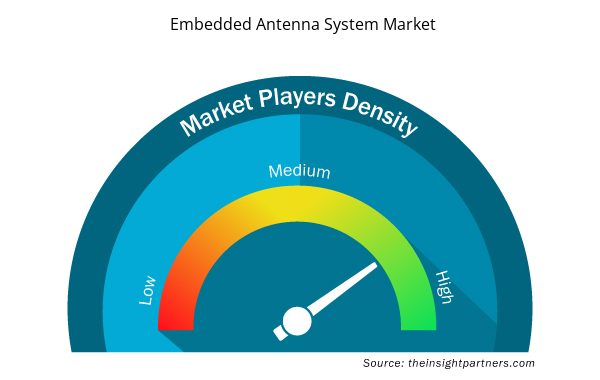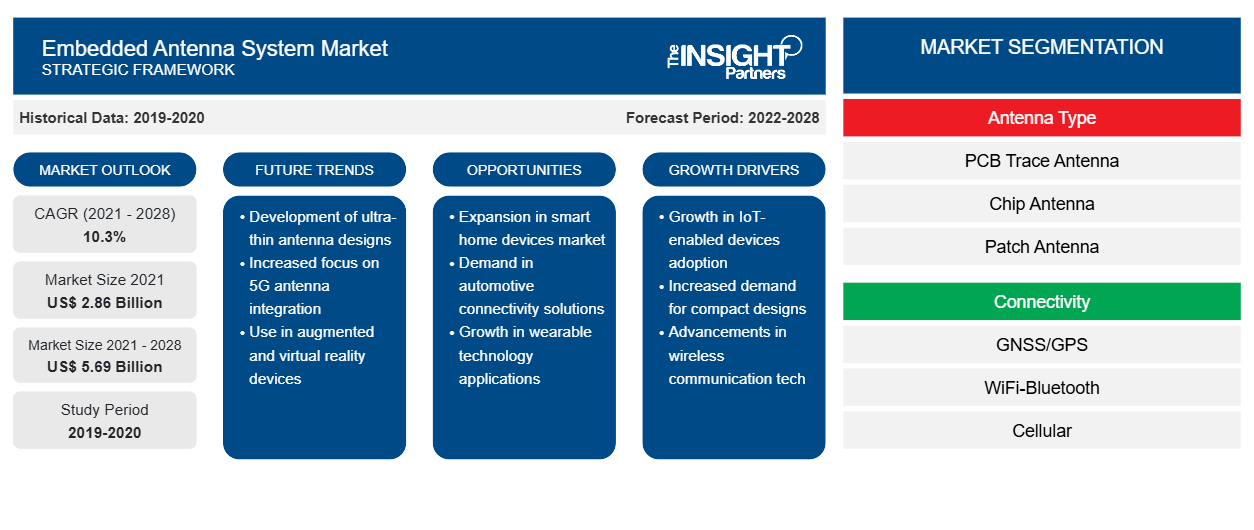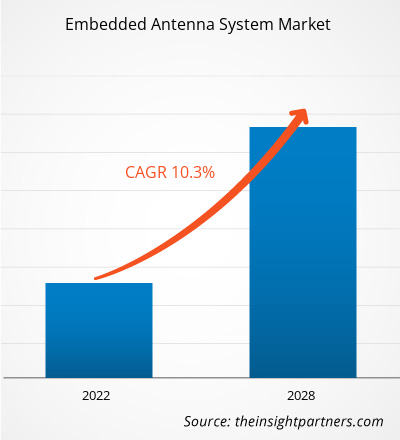Se espera que el mercado de sistemas de antena integrados crezca de US$ 5.685,63 millones en 2028 a US$ 2.858,37 millones en 2021; se estima que crecerá a una CAGR del 10,3% entre 2021 y 2028.
Una antena integrada utiliza metamateriales para mejorar el rendimiento de los sistemas de antena pequeños. El sistema de antena integrada utiliza una antena electromagnética para generar energía en el espacio libre. Los metamateriales están diseñados con estructuras únicas, típicamente microscópicas, para producir propiedades físicas inesperadas. La creciente penetración de tecnologías avanzadas, como Internet de las cosas (IoT), 5G e inteligencia artificial , respalda el crecimiento del mercado de sistemas de antenas integradas. El uso cada vez mayor de sistemas integrados en dispositivos IoT, la creciente demanda de antenas inteligentes para trabajo remoto en el sector de la salud, la creciente prevalencia de Internet, el aumento en el número de usuarios de teléfonos inteligentes y los avances en las tecnologías 5G son las principales fuerzas que impulsan el crecimiento del mercado. Además, se espera que la creciente necesidad de sistemas de antenas integradas en hogares inteligentes, redes inteligentes, automóviles conectados, termostatos inteligentes, etc., impulse el crecimiento del mercado durante el período de pronóstico. El uso creciente de productos electrónicos de consumo, como teléfonos inteligentes y computadoras portátiles, en países desarrollados y en desarrollo se atribuye principalmente al aumento de los ingresos disponibles, el aumento de la población y la creciente penetración de Internet. Los avances en las tecnologías de teléfonos inteligentes y la creciente digitalización se encuentran entre otros factores importantes que impulsan el crecimiento del mercado de sistemas de antenas integradas.
El mercado de sistemas de antenas integradas está segmentado en función del tipo de antena, la conectividad, el uso final y la geografía. Según el tipo de antena, el mercado se segmenta en antenas de trazas de PCB, antenas de chip, antenas de parche, antenas de circuito impreso flexible y otras. Sobre la base de la conectividad, el mercado se segmenta en GNSS/GPS, WiFi-Bluetooth, celular, mmWave (5G), LPWAn, RFID y UWB. Según el uso final, el mercado de sistemas de antenas integradas se segmenta en electrónica de consumo, comunicaciones, atención médica, aeroespacial y defensa, industrial, automotriz y transporte, y otros. Según la geografía, el tamaño general del mercado de sistemas de antenas integradas se segrega principalmente en América del Norte, Europa, Asia Pacífico (APAC), Medio Oriente y África (MEA) y América del Sur.
Airgain, Inc.; Antenova ltd.; Infinite Electronics International, inc.; Kyocera AVX Components Corporation; Mitsubishi Materials Corporation; MOLEX; LINX Technologies; TE Connectivity; Walsin Technology Corporation; YAGEO Group; TAOGLAS; Tallysman; Panorama Antennas ltd; Mobile Mark, inc.; y 2J Antennas SRO son los actores clave perfilados durante el estudio de mercado de sistemas de antenas integradas. Además, se analizan y estudian varios otros fabricantes importantes de sistemas de antenas integradas durante el curso del análisis de mercado para obtener una visión holística del mercado global de sistemas de antenas integradas y su ecosistema., Inc.; Antenova ltd.; Infinite Electronics International, inc.; Kyocera AVX Components Corporation; Mitsubishi Materials Corporation; MOLEX; LINX Technologies; TE Connectivity; Walsin Technology Corporation; YAGEO Group; TAOGLAS; Tallysman; Panorama Antennas ltd; Mobile Mark, inc.; and 2J Antennas S.R.O. are the key players profiled during the embedded antenna system market study. In addition, several other significant embedded antenna system makers are analyzed and studied during the course of market analysis to get a holistic view of the global embedded antenna system market and its ecosystem.
Personalice este informe según sus necesidades
Obtendrá personalización en cualquier informe, sin cargo, incluidas partes de este informe o análisis a nivel de país, paquete de datos de Excel, así como también grandes ofertas y descuentos para empresas emergentes y universidades.
- Obtenga las principales tendencias clave del mercado de este informe.Esta muestra GRATUITA incluirá análisis de datos, desde tendencias del mercado hasta estimaciones y pronósticos.
Impacto de la pandemia de COVID-19 en el mercado de sistemas de antenas integradas
A lo largo de los años, la adopción de sistemas de antenas integradas ha aumentado sustancialmente en todas las industrias para mejorar el rendimiento de los productos y ofrecer flexibilidad de diseño. Sin embargo, la aparición de la pandemia de COVID-19 afectó a varias industrias, como la fabricación de equipos industriales, la automoción y el transporte, y la electrónica de consumo. Los gobiernos promulgaron restricciones de viaje y distanciamiento social, entre otras medidas, para combatir la propagación del nuevo coronavirus, lo que provocó el cierre temporal de las unidades de fabricación en el primer y segundo trimestre de 2020. Sin embargo, con la normalización de las actividades económicas, las instalaciones de fabricación comenzaron a operar con el 50% de su capacidad en el tercer trimestre de 2020. Según la Oficina Federal de Estadística de Europa, el sector minorista de la región experimentó los efectos adversos de la pandemia. Según la organización, como resultado de la segunda ola del brote de COVID-19, Alemania experimentó una disminución del 9% en la facturación minorista total en febrero de 2021. Esta disminución provocó una reducción de la necesidad de sistemas POS minoristas, lo que obstaculizó la demanda de sistemas de antenas integradas por parte de los fabricantes de sistemas POS. Sin embargo, con la disminución de las tasas de infección, las rápidas campañas de vacunación y las iniciativas gubernamentales que promueven la recuperación económica, varias industrias comenzaron a operar con normalidad a partir del tercer trimestre de 2020. Por lo tanto, el mercado de sistemas de antenas integradas se está recuperando rápidamente para superar los efectos negativos causados por la pandemia de COVID-19.POS systems, which hindered the demand for embedded antenna systems from the POS system manufacturers. However, with lowering infection rates, rapid vaccination drives, and government initiatives promoting economic recovery, various industries began operating normally from the Q3 of 2020. Thus, the embedded antenna systems market is reviving rapidly to overcome the negative effects caused by the COVID-19 pandemic.
Perspectivas del mercado de sistemas de antenas integradas
La creciente adopción de sistemas de antena integrados en la industria de la electrónica de consumo impulsa el crecimiento del mercado
Los dispositivos electrónicos de consumo, como teléfonos inteligentes, computadoras portátiles, televisores inteligentes, dispositivos portátiles, tabletas, consolas de juegos y dispositivos periféricos, utilizan sistemas de antena integrados para aplicaciones inalámbricas, como Bluetooth, WLAN, Wi-Fi y GPS. El uso creciente de teléfonos inteligentes y computadoras portátiles, entre otros, en países desarrollados y en desarrollo se atribuye principalmente al aumento de los ingresos disponibles, el aumento de la población y la creciente penetración de Internet. Los avances en las tecnologías de teléfonos inteligentes y el aumento de la digitalización impulsan el crecimiento del mercado de sistemas de antena integrados. Además, con el aumento de la popularidad de Bluetooth, la demanda de auriculares, teléfonos inteligentes, dispositivos portátiles, consolas de juegos y otros productos electrónicos de consumo también está aumentando, lo que contribuye al crecimiento del mercado de antenas integradas.
Los avances tecnológicos en curso han llevado a un aumento en la penetración de dispositivos electrónicos de consumo en varias economías. Según la Asociación de Tecnología del Consumidor (CTA), las ventas de teléfonos inteligentes en los EE. UU. representaron 152 millones de unidades en 2020. Además, según la Corporación Internacional de Datos (IDC), los envíos de teléfonos inteligentes aumentaron un 5,3% interanual y alcanzaron los 1.350 millones de unidades en 2021.
Perspectivas regionales del mercado de sistemas de antenas integradas
Los analistas de Insight Partners explicaron en detalle las tendencias y los factores regionales que influyen en el mercado de sistemas de antenas integradas durante el período de pronóstico. Esta sección también analiza los segmentos y la geografía del mercado de sistemas de antenas integradas en América del Norte, Europa, Asia Pacífico, Oriente Medio y África, y América del Sur y Central.

- Obtenga datos regionales específicos para el mercado de sistemas de antena integrados
Alcance del informe de mercado sobre sistemas de antenas integradas
| Atributo del informe | Detalles |
|---|---|
| Tamaño del mercado en 2021 | US$ 2.86 mil millones |
| Tamaño del mercado en 2028 | 5.69 mil millones de dólares estadounidenses |
| CAGR global (2021-2028) | 10,3% |
| Datos históricos | 2019-2020 |
| Período de pronóstico | 2022-2028 |
| Segmentos cubiertos | Por tipo de antena
|
| Regiones y países cubiertos | América del norte
|
| Líderes del mercado y perfiles de empresas clave |
|
Densidad de actores del mercado de sistemas de antenas integradas: comprensión de su impacto en la dinámica empresarial
El mercado de sistemas de antenas integradas está creciendo rápidamente, impulsado por la creciente demanda de los usuarios finales debido a factores como la evolución de las preferencias de los consumidores, los avances tecnológicos y una mayor conciencia de los beneficios del producto. A medida que aumenta la demanda, las empresas amplían sus ofertas, innovan para satisfacer las necesidades de los consumidores y aprovechan las tendencias emergentes, lo que impulsa aún más el crecimiento del mercado.
La densidad de actores del mercado se refiere a la distribución de las empresas o firmas que operan dentro de un mercado o industria en particular. Indica cuántos competidores (actores del mercado) están presentes en un espacio de mercado determinado en relación con su tamaño o valor total de mercado.
Las principales empresas que operan en el mercado de sistemas de antenas integradas son:
- Airgain, Inc
- Antenova Ltd.
- Electrónica Infinita Internacional, Inc.
- Corporación de componentes AVX de Kyocera
- Corporación de materiales Mitsubishi
Descargo de responsabilidad : Las empresas enumeradas anteriormente no están clasificadas en ningún orden particular.

- Obtenga una descripción general de los principales actores clave del mercado de sistemas de antenas integradas
Perspectivas del mercado basadas en el tipo de antena
Según el tipo de antena, el mercado de sistemas de antenas integradas se segmenta en antenas de circuito impreso, antenas de chip, antenas de parche, antenas de circuito impreso flexibles y otras. En 2020, el segmento de antenas de circuito impreso representó la mayor participación de mercado.
Perspectivas de mercado basadas en el uso final
Según el uso final, el mercado de sistemas de antenas integradas se segmenta en electrónica de consumo, comunicaciones, atención médica, aeroespacial y defensa, industria, automoción y transporte, entre otros. En 2020, el segmento de electrónica de consumo representó la mayor participación de mercado.
Los actores que operan en el mercado de sistemas de antenas integradas adoptan estrategias como fusiones, adquisiciones e iniciativas de mercado para mantener sus posiciones en el mercado. A continuación, se enumeran algunos de los desarrollos de los actores clave:
- En enero de 2022, KYOCERA AVX lanzó la placa de evaluación para probar el rendimiento de conmutación de banda de antena en CES 2022 en Las Vegas.
- En agosto de 2021, TE Connectivity TE firmó un acuerdo definitivo para adquirir el negocio de Antenas de Laird Connectivity.
- Análisis histórico (2 años), año base, pronóstico (7 años) con CAGR
- Análisis PEST y FODA
- Tamaño del mercado Valor/volumen: global, regional, nacional
- Industria y panorama competitivo
- Conjunto de datos de Excel



Report Coverage
Revenue forecast, Company Analysis, Industry landscape, Growth factors, and Trends

Segment Covered
This text is related
to segments covered.

Regional Scope
North America, Europe, Asia Pacific, Middle East & Africa, South & Central America

Country Scope
This text is related
to country scope.
Preguntas frecuentes
The increasing number of connected devices and high-speed internet connectivity has increased the adoption of 5G network. Also, telecommunications companies use 5G antennas to handle the high speed, capacity, and bandwidth of 5G networks. Therefore, the development of 5G is likely to present attractive prospects for the embedded antenna systems market players during the forecast period.
The embedded antenna system has been in use for several years worldwide, however, the technology has been experiencing immense demand in recent years Increasing adoption of the embedded antenna system in the consumer electronics industry and the rising emergence of IoT-based devices/technology are supporting the growth of embedded antenna system market.
The global embedded antenna system market was dominated by the PCB trace antenna segment accounted for the largest share in 2021 during the forecast period. PCB trace antenna is anticipated to continue driving the embedded antenna system market by antenna type segment due to the significant adoption in various applications such as consumer electronics, industrial, and others.
In 2021, APAC led the market with a substantial revenue share, followed by North America and Europe. China is the leading country in APAC for embedded antenna systems, and it is expected to rise rapidly over the projection period, followed by the Rest of APAC and Japan. With the elevating internet penetration rate, consumer electronics manufacturers are poised to launch advanced connected appliances in the region.
The major companies in embedded antenna system market include TE Connectivity, Kyocera AVX Components Corporation, Amphenol, Yageo Group, and Molex. The ranking has been derived by analyzing multiple parameters such as annual revenue earned from embedded antenna system portfolio, client base, geographic locations, R&D expenditure, brand image, and the number of employees, among others. These companies are actively participating in developing embedded antenna systems for various applications.
China held the largest share in the APAC region. The country is the largest consumer electronics market. All major consumer electronics companies have a strong manufacturing presence in the country owing to which the adoption rate of the embedded antenna system is on the higher side. Also, the country is the second-largest arms manufacturer in the world. Aviation Industry Corporation of China, China North Industries Group Corporation Limited, China Aerospace Science and Industry Corporation, and China South Industries Group are the leading defense contractors in the country which produces a notable number of advanced military communication, weapons, aircraft, and an armored vehicle. Thus, these factors are driving the growth of the embedded antenna system market in China.
Trends and growth analysis reports related to Electronics and Semiconductor : READ MORE..
TheList of Companies - Embedded Antenna System Market
- Airgain, Inc
- Antenova ltd
- Infinite Electronics International, inc
- Kyocera AVX Components Corporation
- Mitsubishi Materials Corporation
- MOLEX
- LINX Technologies
- TE Connectivity
- Walsin Technology Corporation
- YAGEO Group
- TAOGLAS
- Tallysman
- Panorama Antennas ltd
- Mobile Mark, inc
- 2J Antennas, S.R.O.
The Insight Partners performs research in 4 major stages: Data Collection & Secondary Research, Primary Research, Data Analysis and Data Triangulation & Final Review.
- Data Collection and Secondary Research:
As a market research and consulting firm operating from a decade, we have published and advised several client across the globe. First step for any study will start with an assessment of currently available data and insights from existing reports. Further, historical and current market information is collected from Investor Presentations, Annual Reports, SEC Filings, etc., and other information related to company’s performance and market positioning are gathered from Paid Databases (Factiva, Hoovers, and Reuters) and various other publications available in public domain.
Several associations trade associates, technical forums, institutes, societies and organization are accessed to gain technical as well as market related insights through their publications such as research papers, blogs and press releases related to the studies are referred to get cues about the market. Further, white papers, journals, magazines, and other news articles published in last 3 years are scrutinized and analyzed to understand the current market trends.
- Primary Research:
The primarily interview analysis comprise of data obtained from industry participants interview and answers to survey questions gathered by in-house primary team.
For primary research, interviews are conducted with industry experts/CEOs/Marketing Managers/VPs/Subject Matter Experts from both demand and supply side to get a 360-degree view of the market. The primary team conducts several interviews based on the complexity of the markets to understand the various market trends and dynamics which makes research more credible and precise.
A typical research interview fulfils the following functions:
- Provides first-hand information on the market size, market trends, growth trends, competitive landscape, and outlook
- Validates and strengthens in-house secondary research findings
- Develops the analysis team’s expertise and market understanding
Primary research involves email interactions and telephone interviews for each market, category, segment, and sub-segment across geographies. The participants who typically take part in such a process include, but are not limited to:
- Industry participants: VPs, business development managers, market intelligence managers and national sales managers
- Outside experts: Valuation experts, research analysts and key opinion leaders specializing in the electronics and semiconductor industry.
Below is the breakup of our primary respondents by company, designation, and region:

Once we receive the confirmation from primary research sources or primary respondents, we finalize the base year market estimation and forecast the data as per the macroeconomic and microeconomic factors assessed during data collection.
- Data Analysis:
Once data is validated through both secondary as well as primary respondents, we finalize the market estimations by hypothesis formulation and factor analysis at regional and country level.
- Macro-Economic Factor Analysis:
We analyse macroeconomic indicators such the gross domestic product (GDP), increase in the demand for goods and services across industries, technological advancement, regional economic growth, governmental policies, the influence of COVID-19, PEST analysis, and other aspects. This analysis aids in setting benchmarks for various nations/regions and approximating market splits. Additionally, the general trend of the aforementioned components aid in determining the market's development possibilities.
- Country Level Data:
Various factors that are especially aligned to the country are taken into account to determine the market size for a certain area and country, including the presence of vendors, such as headquarters and offices, the country's GDP, demand patterns, and industry growth. To comprehend the market dynamics for the nation, a number of growth variables, inhibitors, application areas, and current market trends are researched. The aforementioned elements aid in determining the country's overall market's growth potential.
- Company Profile:
The “Table of Contents” is formulated by listing and analyzing more than 25 - 30 companies operating in the market ecosystem across geographies. However, we profile only 10 companies as a standard practice in our syndicate reports. These 10 companies comprise leading, emerging, and regional players. Nonetheless, our analysis is not restricted to the 10 listed companies, we also analyze other companies present in the market to develop a holistic view and understand the prevailing trends. The “Company Profiles” section in the report covers key facts, business description, products & services, financial information, SWOT analysis, and key developments. The financial information presented is extracted from the annual reports and official documents of the publicly listed companies. Upon collecting the information for the sections of respective companies, we verify them via various primary sources and then compile the data in respective company profiles. The company level information helps us in deriving the base number as well as in forecasting the market size.
- Developing Base Number:
Aggregation of sales statistics (2020-2022) and macro-economic factor, and other secondary and primary research insights are utilized to arrive at base number and related market shares for 2022. The data gaps are identified in this step and relevant market data is analyzed, collected from paid primary interviews or databases. On finalizing the base year market size, forecasts are developed on the basis of macro-economic, industry and market growth factors and company level analysis.
- Data Triangulation and Final Review:
The market findings and base year market size calculations are validated from supply as well as demand side. Demand side validations are based on macro-economic factor analysis and benchmarks for respective regions and countries. In case of supply side validations, revenues of major companies are estimated (in case not available) based on industry benchmark, approximate number of employees, product portfolio, and primary interviews revenues are gathered. Further revenue from target product/service segment is assessed to avoid overshooting of market statistics. In case of heavy deviations between supply and demand side values, all thes steps are repeated to achieve synchronization.
We follow an iterative model, wherein we share our research findings with Subject Matter Experts (SME’s) and Key Opinion Leaders (KOLs) until consensus view of the market is not formulated – this model negates any drastic deviation in the opinions of experts. Only validated and universally acceptable research findings are quoted in our reports.
We have important check points that we use to validate our research findings – which we call – data triangulation, where we validate the information, we generate from secondary sources with primary interviews and then we re-validate with our internal data bases and Subject matter experts. This comprehensive model enables us to deliver high quality, reliable data in shortest possible time.


 Obtenga una muestra gratuita de este informe
Obtenga una muestra gratuita de este informe